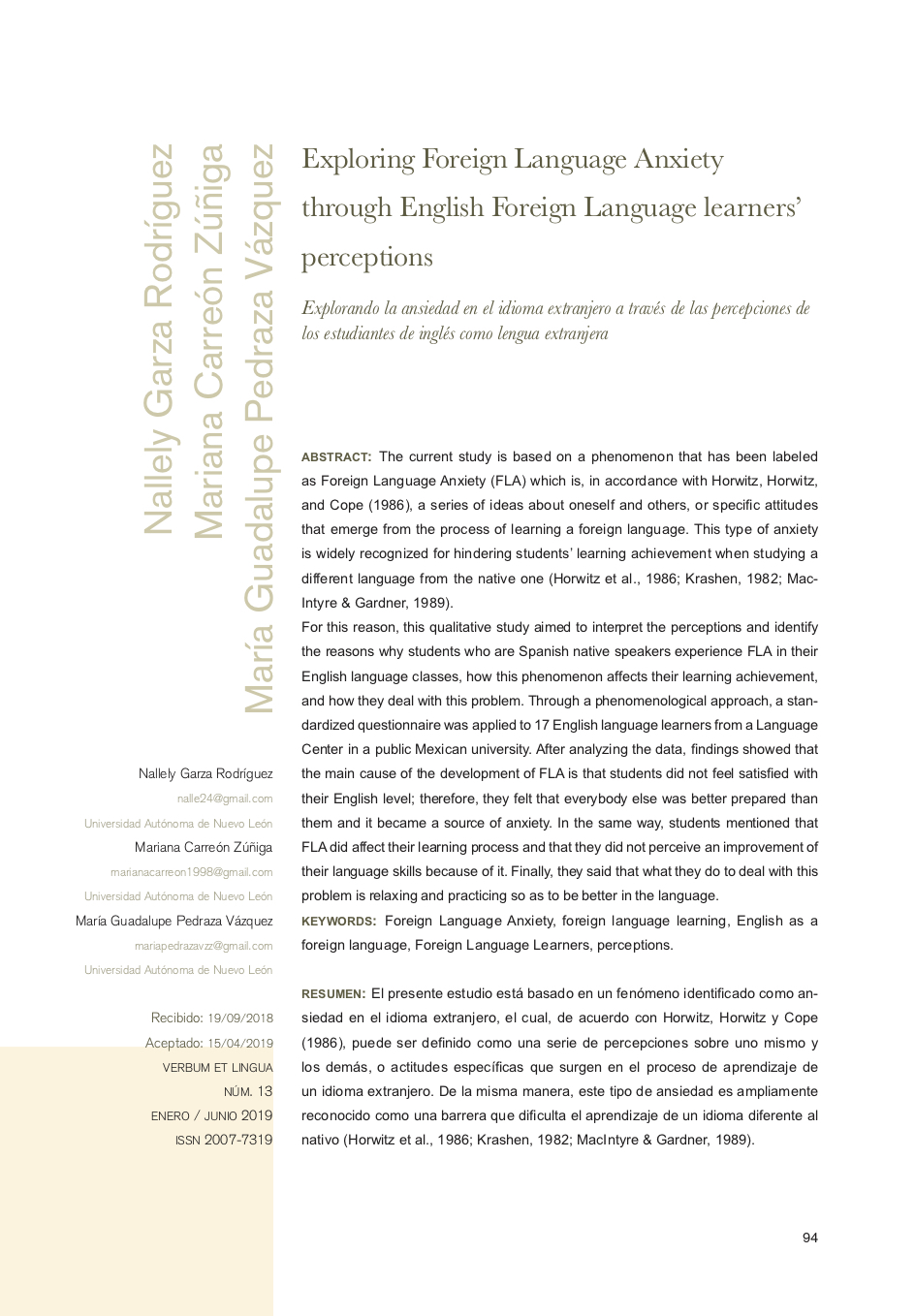Exploring Foreign Language Anxiety through English Foreign Language learners’ perceptions
DOI:
https://doi.org/10.32870/vel.vi13.123Palabras clave:
Ansiedad en el idioma extranjero, aprendizaje de idiomas extranjeros, inglés como lengua extranjera, estudiantes de lengua extranjera, percepciones.Resumen
El presente estudio está basado en un fenómeno identificado como ansiedad en el idioma extranjero, el cual, de acuerdo con Horwitz, Horwitz y Cope (1986), puede ser definido como una serie de percepciones sobre uno mismo y los demás, o actitudes específicas que surgen en el proceso de aprendizaje de un idioma extranjero. De la misma manera, este tipo de ansiedad es ampliamente reconocido como una barrera que dificulta el aprendizaje de un idioma diferente al nativo (Horwitz et al., 1986; Krashen, 1982; MacIntyre & Gardner, 1989).
Por esta razón, este estudio cualitativo ha tenido como objetivos principales identificar las razones por las cuales algunos estudiantes de habla española experimentan ansiedad en el idioma extranjero en sus clases de inglés, explorar cómo este fenómeno afecta su aprovechamiento académico y entender la manera en que ellos lidian con este problema. A través de un enfoque fenomenológico, un cuestionario estandarizado fue aplicado a 17 estudiantes de inglés de un centro de idiomas de una universidad pública en México. Después de haber analizado la información, los resultados mostraron que la principal causa del desarrollo de ansiedad entre estos estudiantes fue que no se sentían satisfechos con su nivel de inglés y, por lo tanto, creían que sus demás compañeros eran mejores que ellos en el idioma. De la misma manera, los participantes mencionaron que este fenómeno afecta su proceso de aprendizaje. Finalmente, algunas de las formas en las que ellos lidian con este problema es mediante técnicas de relajación y práctica para mejorar en el idioma.
Descargas
Métricas
Citas
Alkhateeb, H. M. (2014). Reading anxiety, classroom anxiety, language motivation, reader self-perception, and Arabic achievement of Arab-American students learning Arabic as a second language. Psychological Reports: Sociocultural Issues in Psychology, 115(3), 1–14.doi:10.2466/11. pr0.115c27z6
Aravena, E. S., Bascuñán, D. P., Briones, H. E., Jara, K. A., Lillo, D. A., Morales, G.J.,…Yumha, E. N. (2015). Second language acquisition theories: Their application in the ministry of education’s curriculum and their expected impact on teacher training programs from three Chilean universities (Undergraduate thesis, Universidad de Chile, Santiago, Chile). Retrieved from http://repositorio.uchile.cl/bitstream/handle/2250/130555/Second-language-acquisition-theories.pdf ?sequence=1
Baran-Łucarz, M. (2013). Phonetics Learning Anxiety – Results of a preliminary study. Research in Language, 11(1), 57-79. doi:10.2478/v10015-012-0005-9
Bensalem, E. (2018). Foreign Language Anxiety of EFL students: Examining the effect of self-efficacy, self-perceived proficiency and sociobiographical variables. Arab World English Journal, 9(2), 38-55. doi:10.24093/awej/vol9no2.3
Creswell, J. (2007). Qualitative inquiry and research design (2nd ed.). Lincoln: University of Nebraska.
Creswell, J. (2012). Educational research: planning, conducting, and evaluating quantitative and qualitative research (4th ed.). Lincoln: Pearson Education.
Dewaele, J.-M. (2007). The effect of multilingualism, sociobiographical, and situational factors on communicative anxiety and foreign language anxiety of mature language learners. International Journal of Bilingualism, 11(4), 391-409. doi:10.1177/13670069070110040301
Dewaele, J. M., & Al-Saraj, T. M. (2015). Foreign Language Classroom Anxiety of Arab learners of English: The effect of personality, linguistic and sociobiographical variables. Studies in Second Language Learning and Teaching, 5(2), 205–228. doi:10.14746/ssllt.2015.5.2.2
Dulay, H., & Burt, M. (1977). Remarks on Creativity in Language Acquisition. In M. Burt, H. Dulay, & M. Finocchiaro
(Eds.), Viewpoints on English as a Second Language (pp. 95-126). New York: Regents.
Eddles-Hirsch, K. (2015). Phenomenology and educational research. International Journal of Advanced Research, 3(8), 251–260. Retrieved from https://researchonline.nd.edu.au/edu_article/171/
Ewald, J. D. (2007). Foreign language learning anxiety in upper-level classes: involving students as researchers. Foreign Language Annals, 40(1), 122-142. doi:10.1111/j.1944-9720.2007.tb02857.x
Flick, U. (2009). An introduction to qualitative research (4th ed.) [ebook]. Retrieved from http://www.dphu.org/uploads/attachements/books/books_89_0.pdf
Garcia de Blakeley, M., Ford, R., & Casey, L. (2017). Second language anxiety among Latino American immigrants in Australia. International Journal of Bilingual Education and Bilingualism, 20(7), 759–772. doi: 10.1080/13670050.2015.1083533
Hashemi, M. (2011). Language stress and anxiety among the English language learners. Procedia-Social and Behavioral núm. 13 / enero-junio / 2019 111 Sciences, 30, 1811-1816. doi:10.1016/j.sbspro.2011.10.349
He, D. (2017). How to cope with Foreign Language Speaking Anxiety effectively? The case of university students in China. Electronic Journal of Foreign Language Teaching, 14(2), 159-174. Retrieved from http://e-flt.nus.edu.sg/
Horwitz, E. K., Horwitz, M. B., & Cope, J. (1986). Foreign language classroom anxiety. The Modern Language Journal, 70(2), 125–132.doi:10.1111/j.1540-4781.1986.tb05256.x
Huang, J. (2012). Overcoming foreign language classroom anxiety. United Kingdom: Nova Science Pub Inc.
Krashen, S. D. (1982). Principles and practice in second language acquisition. Oxford: Pergamon Press Inc.
Laverty, S. M. (2003). Hermeneutic phenomenology and phenomenology: A comparison of historical and methodological considerations. International Journal of Qualitative Methods, 2(3), 21–35. doi:10.1177/160940690300200303
Lien, H-Y. (2016). Effects of EFL individual learner variables on foreign language reading anxiety and metacognitive reading strategy use. Psychological Reports, 119(1), 124–135. doi:10.1177/0033294116659711
Lin, H-C.K., Chao, C-J. & Huang, T-C. (2015). From a perspective on foreign language learning anxiety to develop
an affective tutoring system. Education Tech Research Dev, 63(5), 727-747. doi:10.1007/s11423-015-9385-6
Liu, M. (2018). Bilingual/multilingual learners’ willingness to communicate in and anxiety on speaking Chinese and their associations with self-rated proficiency in Chinese. International Journal of Bilingual Education and Bilingualism, 21(1), 54-69. doi:10.1080/13670050.2015.1127889
Macayan, J. V., Quinto, E. J. M., Otsuka, J. C., & Cueto, A. B. S. (2018). Influence of language learning anxiety on L2 speaking and writing of Filipino engineering students. 3L: The Southeast Asian Journal of English Language Studies, 24(1), 40-55. doi:10.17576/3L-2018-2401-04
MacIntyre, P. D., & Gardner, R. C. (1989). Anxiety and second-language learning: Toward a theoretical clarification. Language Learning,39(2), 251-275. doi:10.1111/j.1467-1770.1989.tb00423.x
MacIntyre, P. D., & Gardner, R. C. (1991). Methods and results in the study of anxiety and language learning: a review of the literature. Language Learning, 41(1), 85-117. doi:10.1111/j.1467-1770.1991.tb00677.x
Mak, B. (2011). An exploration of speaking-in-class anxiety with Chinese ESL learners. System, 39(2), 202–214. doi:10.1016/j.system.2011.04.002
McLeod, S. A. (2018). Questionnaire. Simply Psychology. Retrieved from www.simplypsychology.org/questionnaires.html
Moeller, A. K., & Catalano, T. (2015). Foreign language teaching and learning. International Encyclopedia of the Social & Behavioral Sciences, 9(2), 327-332. doi:10.1016/B978-0-08-097086-8.92082-8
Roberts, T. (2013). Understanding the research methodology of interpretative phenomenological analysis. British
Journal of Midwifery, 21(3), 215–218. doi:10.12968/bjom.2013.21.3.215
Siniscalco, M., & Auriat, N. (2005). Questionnaire design. [ebook]. Retrieved from 112 N. Garza Rodríguez, M. Carreón Zúñiga y M. G. Pedraza Vázquez. Exploring Foreign Language Anxiety... http://unesdoc.unesco.org/images/0021/002145/214555E.pdf{
Woodrow, L. (2006). Anxiety and speaking English as a second language. RELC Journal, 37(3), 308-328. doi:10.1177/ 0033688206071315
Yim, S. Y. (2014). An anxiety model for EFL young learners: A path analysis. System, 42(1), 344–354. doi:10.1016/j. system.2013.12.022
Yin, R. (2011). Qualitative research from start to finish. London: Guilford Press.
Young, D. J. (1990). An Investigation of Students’ Perspectives on Anxiety and Speaking. Foreign Language Annals, 23(6), 539–553.doi:10.1111/j.1944-9720.1990.tb00424.x








